www.chechurubiera.info - an online magazine for fans of Chechu Rubiera
SPAIN . ASTURIAS
IMAGES OF ASTURIAS
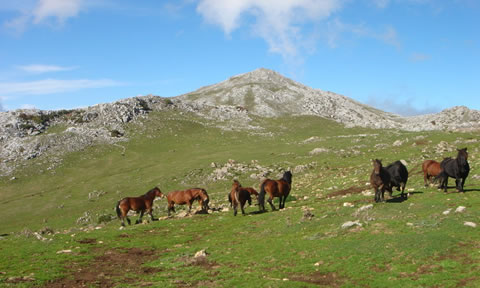
Photograph © Javier Vidal, asturiasenimagenes.com
Chechu's friend Herminio Garcia Aller told us about a wonderful photo website, with 1000 images of Asturias.
It's a very beautiful place. Watch out for the iconic cycling mountains, like the Angliru (above).
Go to Asturian Images
ALONSO'S PASSION FOR CYCLING
by Jose Carlos Carabias, abc.es
"He's out there, with the bike" they say in his office when someone asks for him.
In Asturian mountains or in the Swiss Alps, [Fernando] Alonso prepares his body for the races doing two things in one: he rides, he prepares for races and enjoys his passion.
Long ago, he tasted Angliru's terrible roads, with one of his closest friend, Fernando Azurmendi. The 23 per cent of Cueña les Cabres went through his lungs, but he made it to the summit.
In NY, he fulfilled one of his dreams. He had dinner with Lance Armstrong at Mandarin Hotel in Manhattan.
They met in May 2006, in Monaco, when the American visited Renault's box and they talked about the coming Tour. They had already established a mutual admiration relationship through Chechu Rubiera, the Asturian rider of Astana, former team-mate of the American.
Rubiera is a personal friend of Alonso (they rode together many times on northern climbs with the old US Postal jersey) and also a friend of Armstrong. In Monaco, they exchanged phone numbers and they met in NY.
He lives for speed, but his escape is the bike, his favourite sport. He never attended the Tour, but is thinking about going, and he has yet to meet Miguel Indurain, his idol.

Photograph, formula1sport.net
LA PASIÓN CICLISTA DE ALONSO
by Jose Carlos Carabias, abc.es
«Anda por ahí, con la bici», cuentan en su casa o en su despacho cuando se pregunta por él. O en las montañas de Asturias o en los Alpes suizos, Alonso prepara su cuerpo para las carreras matando dos pájaros de un tiro: monta en bici, adquiere fondo y paladea su pasión. Hace tiempo que probó las rampas del Angliru con uno de sus amigos personales, el preparador físico Fernando Azurmendi. El 23 por ciento de la Cueña les Cabres atravesó sus pulmones, como el de todo visitante del coloso del Aramo, pero llegó arriba.
Cena con Armstrong
En Nueva York cumplió uno de sus sueños. Quedó a cenar con Lance Armstrong en el hotel Mandarín de Manhattan. Ambos se habían conocido en mayo de 2006, en Mónaco, cuando el americano le visitó en el box de Renault y hablaron sin cesar del Tour que se avecinaba. Antes Armstrong y Alonso habían mantenido una relación virtual de admiración a través de Chechu Rubiera, el corredor asturiano del Astaná, ex gregario del americano. Rubiera es amigo de Alonso (ha salido a rodar muchas veces con él por los puertos del Norte con el viejo uniforme azul del Us Postal) y también de Armstrong. En Mónaco intercambiaron sus teléfonos móviles y luego se citaron en Nueva York.
Vive en el imperio de la velocidad, pero su remanso de paz es la bicicleta, el deporte que practica con más frecuencia. Nunca ha acudido al Tour, aunque tiene pensado hacerlo, y ni siquiera conoce a Miguel Induráin, su ídolo. Eso sí, sus alusiones al ciclismo son constantes. «Te empiezas a parecer a Pereiro», suele bromear.
PILGRIMAGE TO THE SHRINE
ALTO DE EL ANGLIRU

In Vueltas past, the ascent of the Angliru has proved to be a moment of reckoning for the main protagonists. Both Roberto Heras in 2002, and Chaba Jiménez, three years earlier, won a dramatic stage there, crossing the finish line in the rain, the headlights behind glowing in the fog.
In 1999, the Angliru was a new addition to Vuelta climbs. It was a symbol of defiance. The Tour de France, recovering from Festina, was all about moderation and morality. To the Vuelta organisers, moderation meant tedium and the route around Spain was the most moutainous of the three Grand Tours that year.
Stage 8. It was a rainy Sunday. With two first-category summits already climbed, with crash after crash on the descents, the first riders reached the foot of the Angliru. Russian Ivanov led, "but closing fast was a group that included Tonkov, Chaba Jiménez, Rubiera, Ullrich and Heras."
They reached the appalling final kilometres. With just 1km to go, Tonkov was caught, and Jiménez was first over the line. Chechu finished 8th, at 2'45". He swore it was "the hardest puerto I've climbed in my life".
On first glance, the vital statistics of the climb are not overly impressive, 13km long reaching an altitude of 1,558 metres.
A more detailed look reveals intimidating ramps of 23% (the Tourmalet max. 13%, Mortirolo 18%). The steepest is known as Cueña les Cabres, three kilometres from the summit. Even then, it doesn't ease up, there are two later ramps of 18 to 21%.
VUELTA A ASTURIAS : 3 May 2007
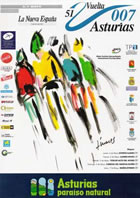 The 51st Vuelta a Asturias gets underway today, with a 150km stage from the principality capital of Oviedo to the eastern coastal town, Llanes.
The 51st Vuelta a Asturias gets underway today, with a 150km stage from the principality capital of Oviedo to the eastern coastal town, Llanes.
Chechu isn't taking part, but he trains each day on these roads and climbs, so it's worth watching to see the scenery. His friend, Santi Pérez and old team-mate José Azevedo, now with Benfica, are scheduled to start today.
The Tour of Asturias is an important race in Spain, it's been won in recent years by some cycling greats, Iban Mayo, Joseba Beloki, Laurent Jalabert, Miguel Indurain, Abraham Olano and Alex Zülle.
Go to the RACE WEBSITE for results and photos.
Check cyclingfans.com for links to live video streaming from Asturias.
TWO DAYS IN GIRONA
Christine Kahane follows the trail in search of Discovery
We decided to head off for a couple of days to Girona, Spain to track down the resident American cyclists, many of whom are still with Discovery Channel.
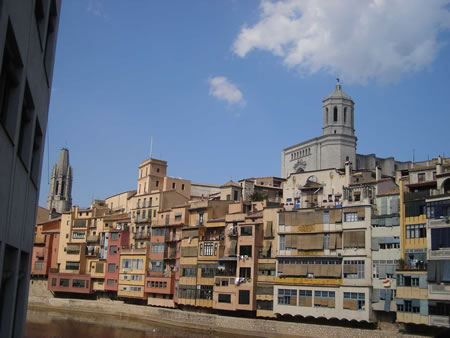 It’s not difficult to understand what attracted them to Girona. The city was built on both sides of the river Onyar and preserves a lovely old town with cobbled narrow and steep streets, but it is also a lively and modern place with a wide choice of shops and catering, everything within walking distance. The city is surrounded by a hilly forested landscape. It’s a perfect place for long hours on the bike.
It’s not difficult to understand what attracted them to Girona. The city was built on both sides of the river Onyar and preserves a lovely old town with cobbled narrow and steep streets, but it is also a lively and modern place with a wide choice of shops and catering, everything within walking distance. The city is surrounded by a hilly forested landscape. It’s a perfect place for long hours on the bike.
On our first day, we visited the medieval part of town and strolled along the path running around the ancient walls dating from emperor Charlemagne, with a spectacular view over the city.
We passed in front of the three-story ancient stone building where Tyler Hamilton and his wife, Haven were once photographed for thePaceline. Lance and his family also lived in this building.
Then, we crossed a quaint bridge over the river Onyar, on its banks are the ancient multicolored houses dating from the Middle Ages. We headed towards the Plaça de la Independencia, a pretty square in the more modern part of town, with flowers and arcades. Here we found Café Boira, the meeting place of the colony of American riders referred to in Michael Barry’s book “Inside the Postal Bus”. Unfortunately, there was no cyclists in sight.
Next day, we visited the famous Cathedral, a mix of Romanesque, Gothic and Baroque styles, and then entered a narrow medieval street in the historical district, where we had heard several professional riders used to rent apartments during the European cycling season until they each bought their own homes in the city.
In a quaint three-story house, on top of a hill next to the Cathedral, we saw the place where Antonio Cruz, Christian Vandevelde, Floyd Landis, Levi Leipheimer, George Hincapie, Tyler Hamilton, Frankie Andreu and of course, Lance Armstrong has all stayed at one time. The lady in charge told us that even today, their relatives stay there when they are visiting Girona.
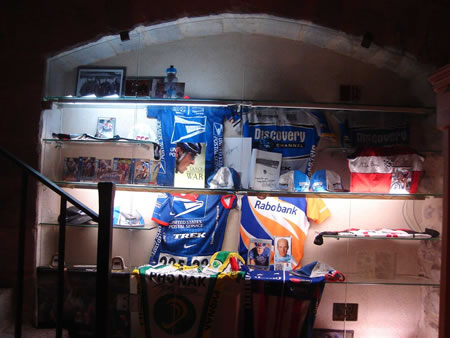
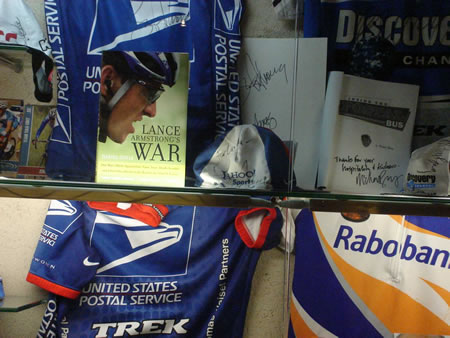 In the hall, there is a wide display of books by or about Lance, autographed photos of all sizes, and cycling kit : jerseys and caps, bidons and other sports items which belonged to riders who had lived in this elegant historical place. I even think I recognized the signature of Chechu on a US Postal jersey. Several photos and jerseys are autographed “for Cristina”. The landlady explained that Cristina is her sister, who was a physiotherapist for all the riders portrayed in this small museum when she worked for the Posties. This was the perfect end to our two days in Girona.
In the hall, there is a wide display of books by or about Lance, autographed photos of all sizes, and cycling kit : jerseys and caps, bidons and other sports items which belonged to riders who had lived in this elegant historical place. I even think I recognized the signature of Chechu on a US Postal jersey. Several photos and jerseys are autographed “for Cristina”. The landlady explained that Cristina is her sister, who was a physiotherapist for all the riders portrayed in this small museum when she worked for the Posties. This was the perfect end to our two days in Girona.
IT'S CHRISTMAS
Traditions at Christmas
“Does Santa really exist?” It’s one of those questions. You know it’s coming, but you don’t know what you’re going to say until it arrives. My response to Alice, aged seven, was that of course he exists. Santa is the spirit of Christmas, goodness and family and giving. The man in red is how we see him. Other people in other lands picture this spirit differently. Whatever our beliefs, we all have a tradition like this.
 In Scotland, holiday and Christmas isn’t a traditional combination. When my dad started his working life, in the 1950s, Christmas Day was just another day. Of course, there were presents, but he didn’t get the day off.
In Scotland, holiday and Christmas isn’t a traditional combination. When my dad started his working life, in the 1950s, Christmas Day was just another day. Of course, there were presents, but he didn’t get the day off.
Scotland’s big moment is New Year. For some reason, we go a bit mad and hedonistic. Hogmanay is party time, we go first-footing after midnight, carrying black bun, whisky and coal. And there's fireworks, lots of fireworks. New Year’s Day and 2 January are holidays, set aside for recovery.
We’re the only country in the UK where 2 January is a public holiday. Needless to say, we’ve now adopted Christmas Day and Boxing Day too, so we get an extra day. Canny!
Christmas in Spain
In Spain, Christmas is a deeply religious holiday. The patron saint is the Virgin Mary and the Christmas season officially begins December 8, with the feast of the Immaculate Conception.
Christmas Eve is known as Nochebuena or the Good Night. Tiny oil lamps are lit in windows. It’s a family affair, they gather to celebrate and feast around Nativity scenes or Nacimiento. Every town and most churches have a nativity display. Some are animated and illuminated and draw huge crowds. The family often ends up at a party, every generation joining in.
Spain is a Catholic country, churches are very busy places during Christmas. At midnight on Christmas Eve, the church bells ring, calling families to la Misa del Gallo, the mass of the rooster.
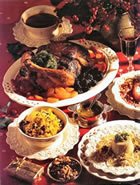 Christmas dinner is not eaten until after midnight mass. It is a family feast, the highlight is often Pavo Trufado de Navidad, Christmas turkey with truffles.
Christmas dinner is not eaten until after midnight mass. It is a family feast, the highlight is often Pavo Trufado de Navidad, Christmas turkey with truffles.
The menu starts with cold shellfish and cold cuts of meat, followed by soup, then baked bream with potatoes, followed by roast lamb, suckling pig, game or turkey. It’s all washed down with cava and topped off with cakes, turrón (almond nougat) and marzipan.
Christmas Day is spent at church, then eating, drinking and making merry.
A custom peculiar to Spain is swinging. Swings are set up and people swing!
28 December is the feast of the Holy Innocents. Young boys of a town or village light bonfires or hogueras, this tradition originated long before Christmas itself. It observes the winter solstice, the shortest day of the year and the beginning of winter. People jump over the fires as a symbolic protection against illness.
New Year celebrations
At New Year, Noche Vieja, the cava flows again, the bars and restaurants are full and everyone is your friend. It all sounds very familiar.
On 5 January, rosca de Reyes is made. This ring-shaped pastry (tasting similar to hot-cross-bun mixture) is covered in sugar and fruit jellies and contains little lucky charms. Every town and city will have a parade, sweets are thrown from floats.
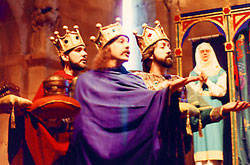 Spanish children receive gifts on the feast of the Epiphany, el día de Reyes.
Spanish children receive gifts on the feast of the Epiphany, el día de Reyes.
The Magi are particularly revered in Spain, the Three Wise Men traditionally bear gifts for children, not Santa Claus. It is believed that they travel through the countryside re-enacting their journey to Bethlehem.
go to top
BRIEF NOTES ON ASTURIAS
It’s no secret that the British love Spain. For forty years, we’ve flown to the Costas and Ballearics for sun, sea ... and the rest! I dropped by my local travel agent and asked if they had anything for northern Spain. She started rummaging for the “office copy” of the one brochure which covers north of Madrid. It was lost, by the way.
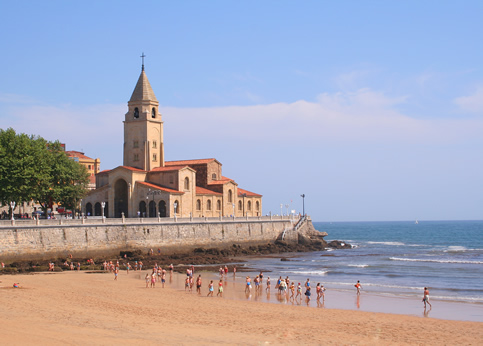
So I logged on and discovered that Asturias has a beautiful landscape and a people proud of their history and culture.
Asturias’ rugged, cliffy coastline looks out on the Bay of Biscay (known locally as the Cantabrian Sea). It is encircled by the provinces of Cantabria, Castilla y Leon and Gallicia. Asturias is a principality within Spain, the heir to the Spanish throne is Prince of Asturias. It has its own regional government and its own language. Ten years ago, there were over 500,000 speakers of Asturian. Over a million people live in Asturias, 2.5% of the total Spanish population.
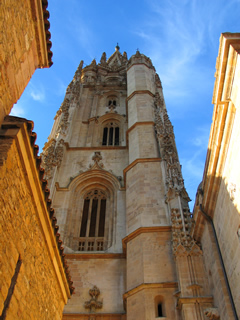 The university town, Oviedo is the capital of Asturias, best known for its pre-Romanesque buildings. “More or less cut off from the rest of Christian Europe by the Muslim invasion, the small, rough-and-tumble kingdom that emerged in the 8th-century gave rise to a style of art and building distinct not only in Spain, by in all of Europe” Lonely Planet.
The university town, Oviedo is the capital of Asturias, best known for its pre-Romanesque buildings. “More or less cut off from the rest of Christian Europe by the Muslim invasion, the small, rough-and-tumble kingdom that emerged in the 8th-century gave rise to a style of art and building distinct not only in Spain, by in all of Europe” Lonely Planet.
Chechu Rubiera lives near Gijón, a vibrant, more commercial city on the coast. I love this tourist information on visitgijon.com, “A city to discover that beats with a pulse of its own – placid at times and frantic at others, like its sea – as you mingle with its townsfolk and lose yourself among its nooks and crannies. Slowly savouring each of these nuances that Gijón keeps for you alone. And for everyone.”
Follow the coast and there are hundreds of sandy beaches, coves and natural sea caves. A “mountainous interior” is formed by the Cantabrian range, the highest and most spectacular peaks are found in the Picos de Europa National Park. The mountains offer opportunities for climbing, walking, skiing and of course, cycling.
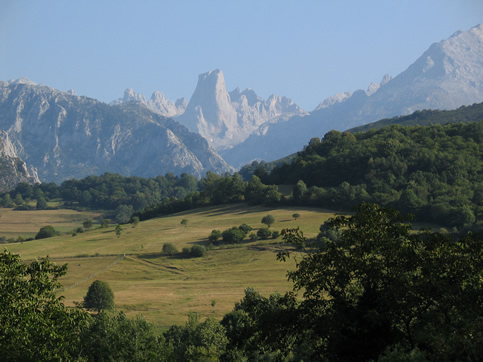
Because of its coastline, Asturias is famous for its seafood, squid, crab, shrimp and sea bass. Its most famous dish is Fabada Asturiana, and locally made cider or sidra, is the traditional alcoholic drink of choice.
Musically, Gijón is a hotbed for new indie bands in Spain, including Manta Ray and Nosotrash. Asturian bagpipe rocker, José Ángel Herea Tejedor, creates popular new music, based of traditional folk songs.
go to top
ASTURIAN. A LANGUAGE IN DECLINE?
Although the official language of Asturias is Spanish, the language spoken by many locals is Asturian. Now protected by law and offered as an optional language in schools, supporters of Asturian claim that, because it is not officially recognised, it may be a dead language within two generations.
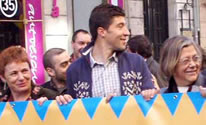 Chechu Rubiera speaks Asturian, he describes it as “a dialect of Spanish, and very similar, although unfortunately it’s becoming obsolete and only a few words are still used between Asturians." He has even taken to the streets to support his local language.
Chechu Rubiera speaks Asturian, he describes it as “a dialect of Spanish, and very similar, although unfortunately it’s becoming obsolete and only a few words are still used between Asturians." He has even taken to the streets to support his local language.
In 1994, there were 100,000 first language speakers of Asturian, with 450,000 able to speak or understand it as a second language. Asturian is most used between relatives, friends and neighbours, its use decreases in public life.
Changes to the local population have taken place since the 1950s, with around 43% immigratinginto the region from the south. They have not absorbed the Asturian culture or language.
In spite of this, the number of young people learning and using it (mostly as a written language) has substantially increased in recent years, mainly among intellectual groups and politically active Asturians, proud of their regional identity.
In recent years, the Academia de la Llingua Asturiana has made efforts to provide the language with most of the tools needed to ensure its survival: a grammar, a dictionary, and periodicals.
A new generation of Asturian writers have also championed the language. There has been literature, both popular and literary, since the 17th century. About 60 books are published in Asturian every year. Asturian music is popular, bands produce mostly Celtic and folk music, although there are also some rock bands. There are several Celtic music festivals held around Asturias. These developments give the Asturian language a greater hope of survival.
And if you want to see what Asturian looks like, one of our contributors sent Chechu this message in Asturian during the summer.
Animo Chechu, esti añu ye el tuyu! Depués de tantu tiempu trabayando pa otru, esperemos que agora te dexen un poco de llibertá pa que pueas repetir triunfos como los del Giro que tanto nos prestaron. Saludos de un tocayu de Mieres.
go to top